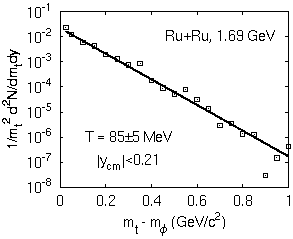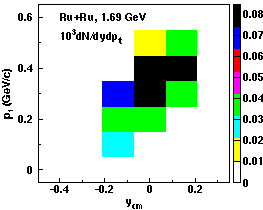|
The study of meson production in heavy-ion collisions
near threshold gives insight in the particle properties
in dense matter. Furthermore information on the equation
of state is provided as the particle production rates depend sensitively
on the potentials the collision partners feel. Recently, the
f meson production was measured in reactions of Ni+Ni and Ru + Ru
at energies of 1.93 and 1.69 A·GeV, respectively [1].
Extrapolations from the limited phase space available
point to a larger cross section than standard
Boltzmann-Ühling-Uhlenbeck (BUU) calculations [2].
These calculations usually
do not consider the production of f mesons by elementary
collisions of r mesons and baryons. The cross sections of
these reactions are larger than those of pions. To study the influence of
these channels a version of the BUU code [3] was used
which explicitly treated r mesons
created in pion-pion collisions or in resonance decays.
This version was applied to central collisions of Ru+Ru with an
impact parameter smaller than 4.2 fm.
We found that 2 ·10-3 f mesons are produced per event
and roughly 2/3 of them stem from r-N
and r-D collisions.
In Fig. 1 we show the transverse mass spectrum at midrapidity
from which an effective temperature of T = 85 MeV is deduced.
Taking into account the detector
acceptance of the
FOPI apparatus [1] the expected f meson distribution
in the rapidity-transverse momentum plane is shown in Fig. 2,
altogether there are 0.8 ·10-5 particles per central event.
This number is still by about a factor of four smaller than the experimental
value of (3.1 ±1.2) ·10-5 [4].

|
|

|
|
Fig. 1
Calculated transverse mass spectrum (open squares) of
f mesons at midrapidity. The solid line shows the fit
to the Boltzmann distribution exp (-mt/T).
|
|
Fig. 2
Calculated distribution of dN/dydpt of f mesons per event
in the
rapidity - transverse momentum plane taking the FOPI detector
acceptance into account.
|
1 KFKI Research Institute for
Particle and Nuclear Physics, H-1525 Budapest, POB 49, Hungary
References
[1] R. Kotte (FOPI collaboration), Proc. Int. Workshop XXVIII,
Hirschegg, Austria, Jan. 2000, p. 112
[2] W.S. Chung, G.Q. Li and C.M. Ko, Nucl. Phys. A 625 (1997) 347
[3] Gy. Wolf, W. Cassing, U. Mosel, Nucl. Phys. A 552 (1993) 549
[4] R. Kotte, this Report
IKH
05/31/01
© H.W. Barz
|

